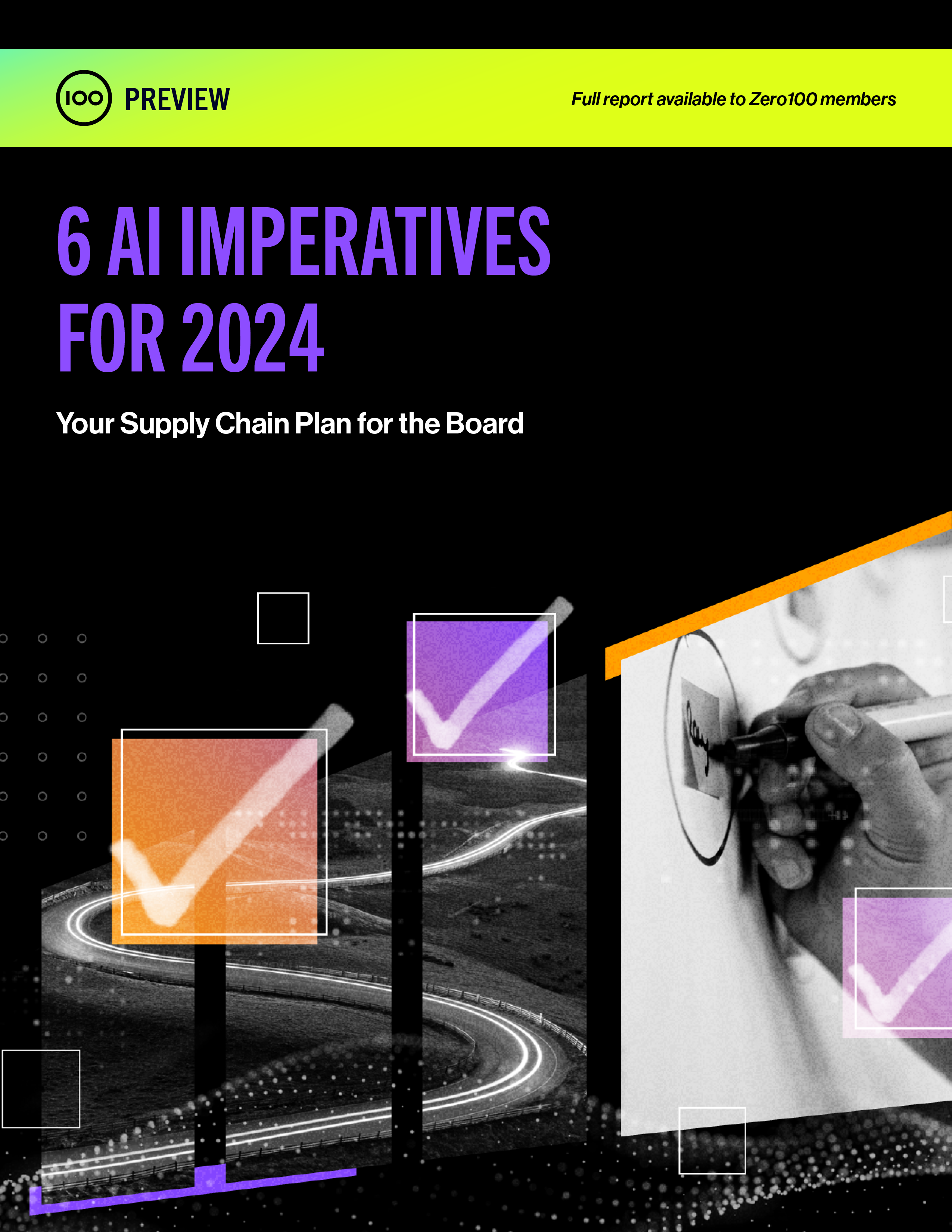
6 AI Imperatives for 2024
Your Supply Chain Plan for the Board
As AI fundamentally reshapes the way supply chains operate, this research report brings together Zero100 research, data, and use cases to lay out six priorities to strengthen your AI strategy across technology and talent over the coming months.
Want to keep reading?
Enter your details to unlock a preview of the research report.
We believe in the power of the supply chain to create a better future—one that is Zero Percent Carbon, 100% Digital. We see a future where human experience is at the center of AI augmentation and we regenerate resources to protect the planet for centuries to come. And 2024 is a year of strategic focus and delivery, collectively moving from ideas to actions.
The full report highlights bold, expansive, and useful insights in relation to the following imperatives to provide an action-oriented plan to drive the end-to-end adoption of AI and ROI.
The Six Imperatives
-
1
Accelerate Your AI Strategy and Bolster AI/ML Skills through Recruiting
In 2023, skill requirements for AI and ML in supply chain jobs grew by 116% across 100 B2C companies. While it may be tempting to discount genAI as hype, the data proves otherwise. At the end of 2022, only 1% of all supply chain jobs posted on LinkedIn mentioned AI/ML skills, and that baseline is now north of 2% as we head into 2024. And, arguably, the most shocking data we found in 2023 was the correlation between AI leadership and hard business results in the form of revenue and gross margin growth.Don’t wait to start investing in testing and learning about the application of genAI in your supply chain. You can read more about the revenue and gross margin growth for AI leaders in our research report, Seizing This AI Moment. Find the preview here.
-
2
Find (and Develop) Talent with Hard and Soft Skills
Looking at more than 2.8M data records, we found that soft skills are being emphasized within role descriptions specifically mentioning AI/ML skills more than in supply chain role descriptions that don’t. Best practices for effective prompt engineering, for example, demonstrate why skills like communication are symbiotic with AI. In December 2023, OpenAI published a guide to prompt engineering, which includes six strategies to get better results from the model. Much of the advice involves providing clarity and context in instructions, being specific, giving the model time to think, coaching on the desired outcome, and, at times, the steps to complete a task. Sound familiar? The things that make us effective leaders now amplify our impact as effective supply chain citizen technologists. Companies are recruiting talent with technical skills and soft skills while also “raising the floor” on technical literacy with their current teams through upskilling programs, talent sharing across regions and functions, and evolved workforce planning strategies.
-
3
Be Deliberate about Your Strategy for Leveraging LLMs in Supply Chain
In 2023, we asked the Zero100 Board what the biggest theme for 2024 would be, and the answer was “More Generative AI!” And while LLMs are not the only application, they are foundational to progressing genAI.With any new technology, product, or service, the question is always: buy or build? In short, building an in-house LLM can be expensive, time-consuming, and challenging to execute.
However, when there is a clear path to value, it can be a competitive differentiator and a learning accelerator. Total cost of ownership (and computer power required), accuracy, speed to market, and security are a few of the driving factors behind investment approaches for LLMs in supply chain. We see a spectrum of experimentation in practice, which we detail in the form of use cases in the full report.
-
4
Future-Proof Your Tech Stack to Make the Most of GenAI
In the last four years, Salesforce has completed 18 acquisitions—a strategy that has consistently kept the company at the forefront of trends and accelerated its growth. Meanwhile, SAP has eroded trust with customers by restricting AI and “green ledger” innovation for customers on the subscription-only cloud-based offering— alienating those who that are using legacy ERP systems or S/4HANNA on-premises.
Arguably, the most painful part is that it prohibits customers from rapidly adopting AI to digitize their supply chains.
The bottom line is that the supply chain tech stack is evolving with AI, and our early insights suggest there are two major unlocks for CSCOs – find them in the full report.
-
5
Leverage NLP and GenAI to Accelerate Margin Growth and Productivity in Sourcing
2024 marks the beginning of a decade of transformation focused on the first mile. Digital leaders are starting to realize the benefits of the untapped potential in sourcing and the power of the CPO to deliver value and create competitive advantage… and the top five digital transformation leaders in sourcing are seeing results in the form of both revenue and gross margin growth.
It’s only in the last few years that a vibrant, innovation-centric startup ecosystem has developed in the sourcing and procurement space, and many of these new vendors claim AI capabilities in their point solutions. We are on the brink of significant change in the realm of sourcing, and digital leaders are leaning in. Find out how in the full report.
-
6
Blueprint Your End-to-End AI Maturity with IT
In a recent interview with Zero100, Mario Guerendo, Head of Global Supply Chain IT at Cummins, emphasizes why his background in IT is so valuable in the world of supply chain. The lines between IT and supply chain are blurring as leading supply chains get closer to the goal of being 100% Digital. The skills needed to successfully prompt AI are not dissimilar to the skills required of a good communicator, making the “analytical relationship-managers” sitting in supply chain (who also understand end-to-end operations) the prime heroes of a digital future. Historically, the product manager role has been a foundational job in IT organizations. Product managers blend soft and hard skills and work cross-functionally to ensure a product’s vision, strategy, features, and development align with customer needs throughout the lifecycle. Of the 175 companies we evaluated between November 2022 and October 2023, 65% are hiring product managers in the supply chain, with digital leaders hiring product managers at 1.4x the rate of their peers.
Intended as a strategic tool focused on critical digital priorities, the full report lays out our proprietary data, insights, and use cases on each of these imperatives, suggesting strategic actions for the coming months and sharing our research on emerging developments. Find the report online at members.zero100.com.
If you are not a Zero100 member, please email hello@zero100.com to enquire about report access and membership options.
